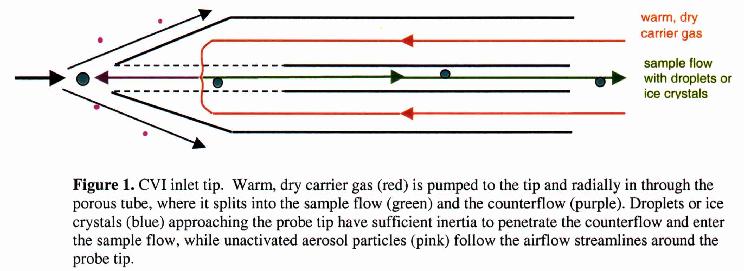
The NCAR counterflow virtual impactor (CVI) (Noone et al., 1988; Twohy et al., 1997) is an airborne instrument that can be used for studies of aerosol/cloud interactions, cloud physics, and climate. At the CVI inlet tip (Figure 1), cloud droplets or ice crystals larger than about 8 µm aerodynamic diameter are separated from the interstitial aerosol and impacted into dry nitrogen gas. This separation is possible via a counterflow stream of nitrogen out the CVI tip, which assures that only larger particles (cloud droplets or ice crystals) are sampled. Because droplets or crystals in a sampling volume of about 200 l/min are impacted into a sample stream of approximately 10 l/min, concentrations within the CVI are significantly enhanced. The water vapor and non-volatile residual nuclei remaining after droplet evaporation are sampled downstream of the inlet with selected instruments. These may include a Lyman-alpha or similar hygrometer, a condensation nucleus counter, an optical particle counter, filters for chemical analyses, or user instruments.
A list of publications that utilize CVI data from the U.S. and Europe can be found here.
Contact Cynthia Twohy for more information.

References
Noone, K.J., Ogren, J.A., Heintzenberg, J., Charlson, R.J. and D.S. Covert, 1988: Design and calibration of a counterflow virtual impactor for sampling of atmospheric fog and cloud droplets, Aer. Sci. Technol., 8, 235-244.
Twohy, C.H., Schanot, A.J. and W.A. Cooper, 1997: Measurement of condensed water content in liquid and ice clouds using an airborne counterflow virtual impactor, J. Atmos. Oceanic Technol., 14, 197-202.